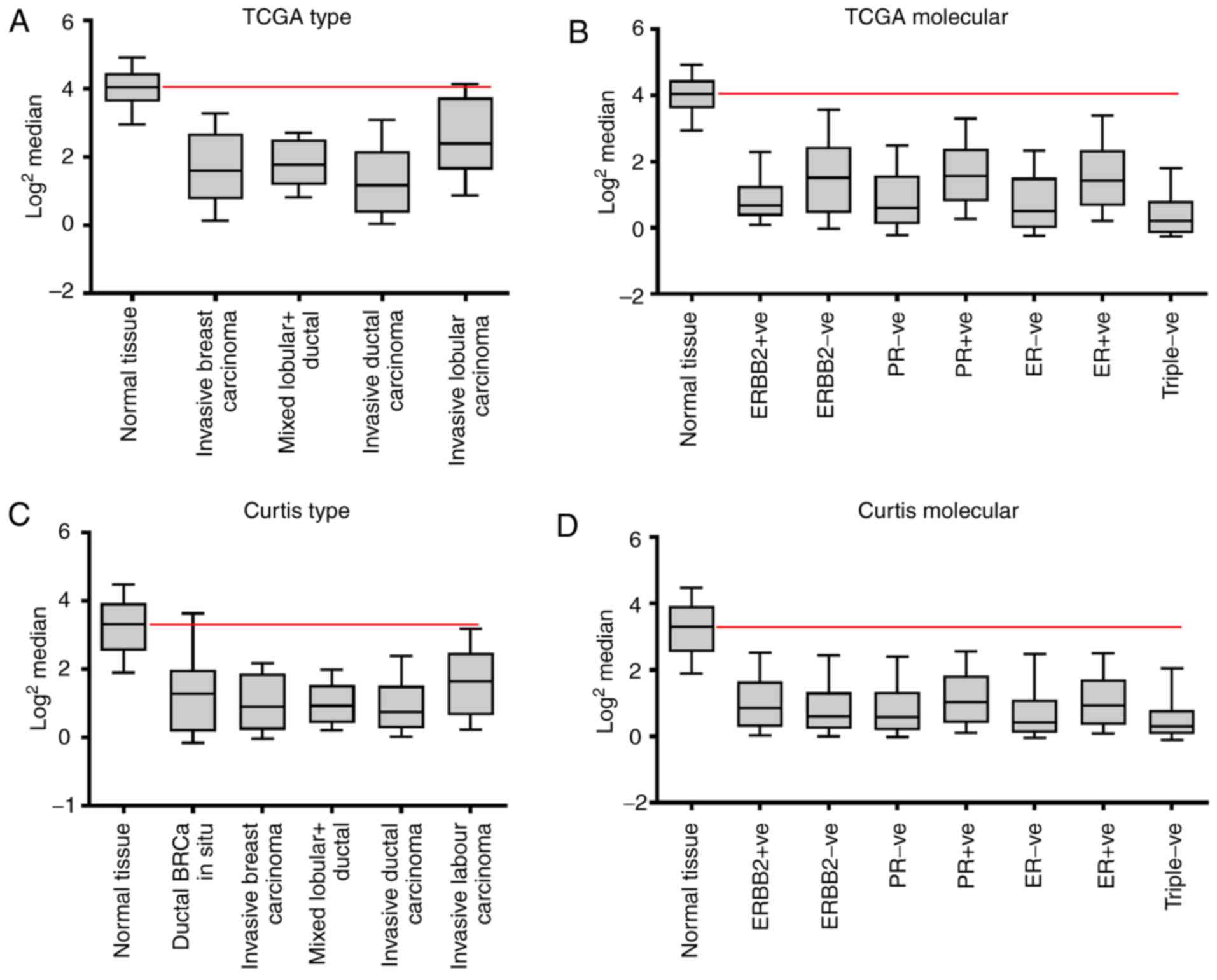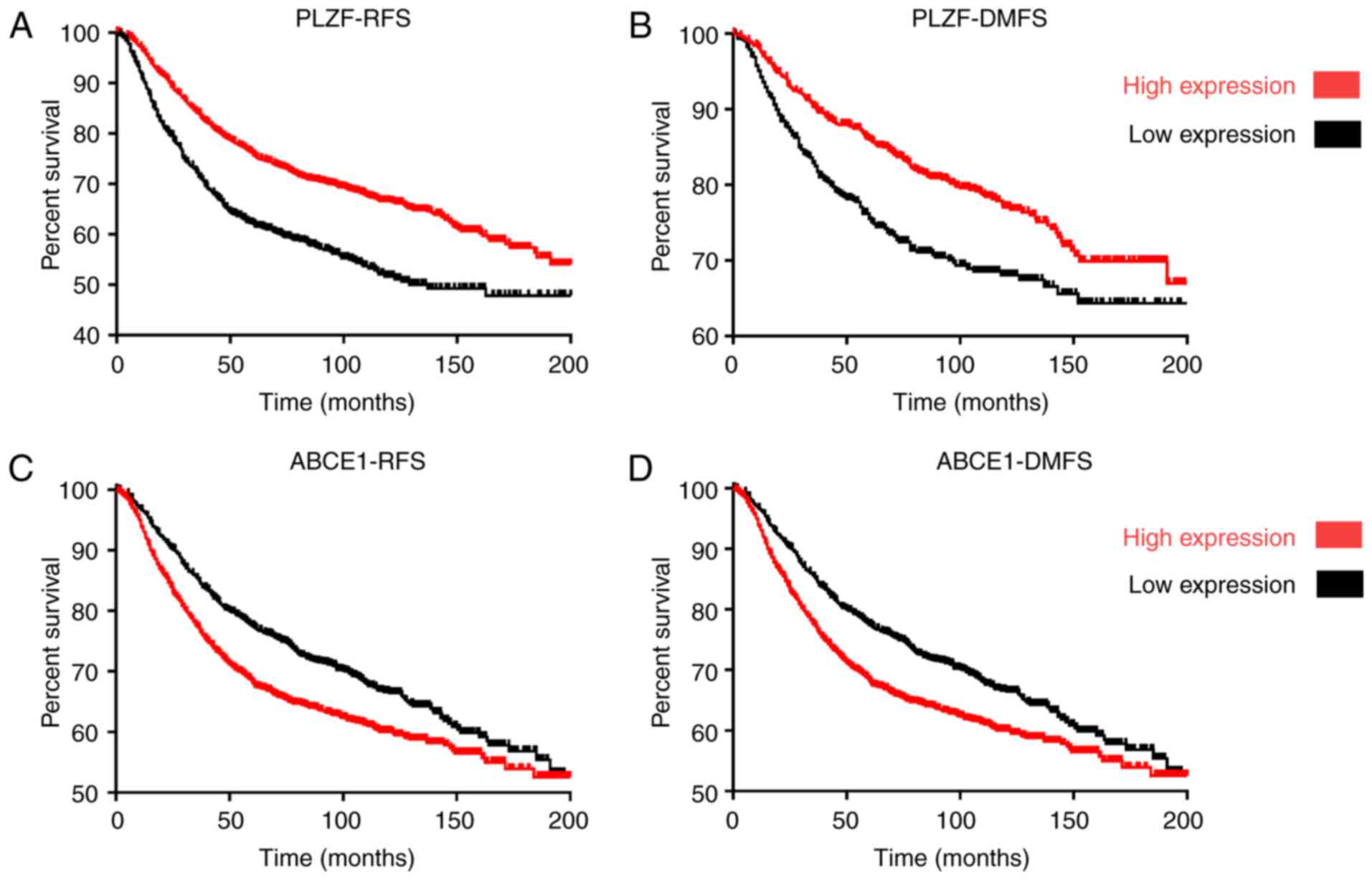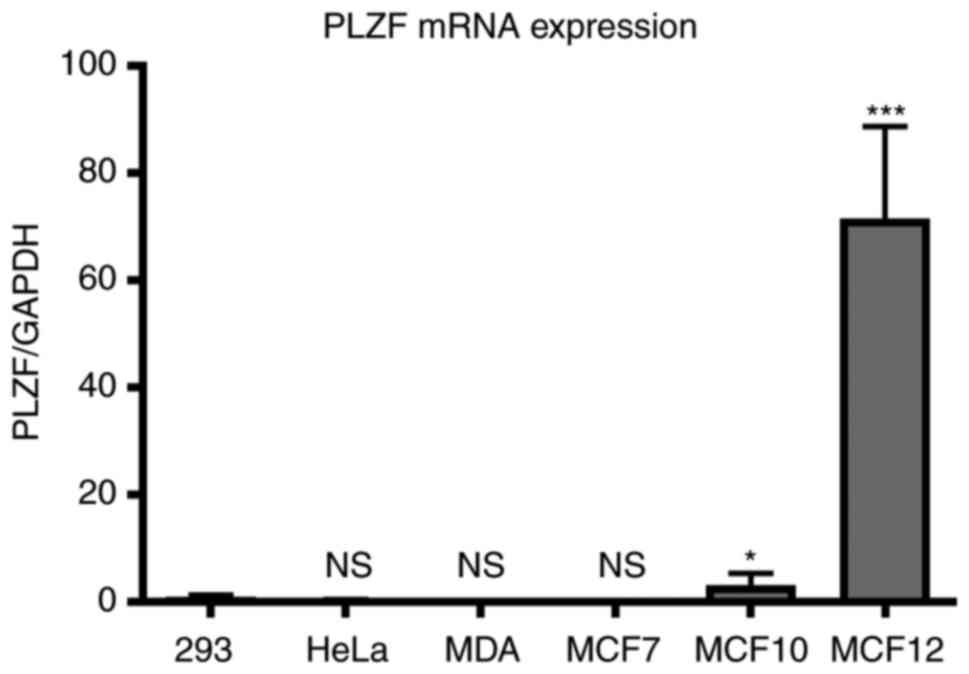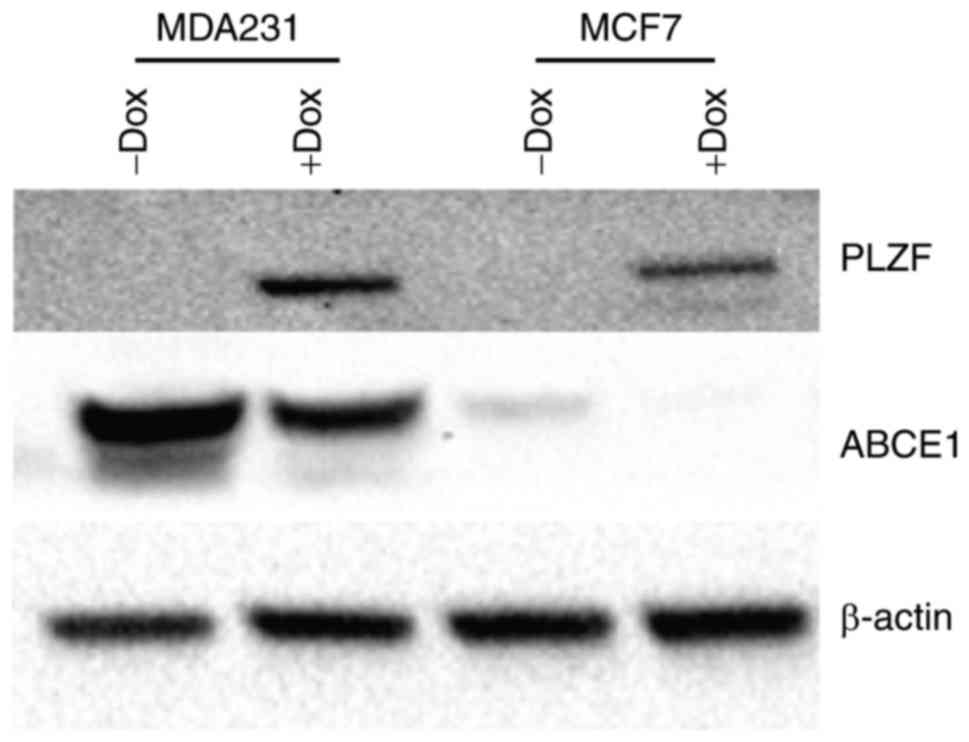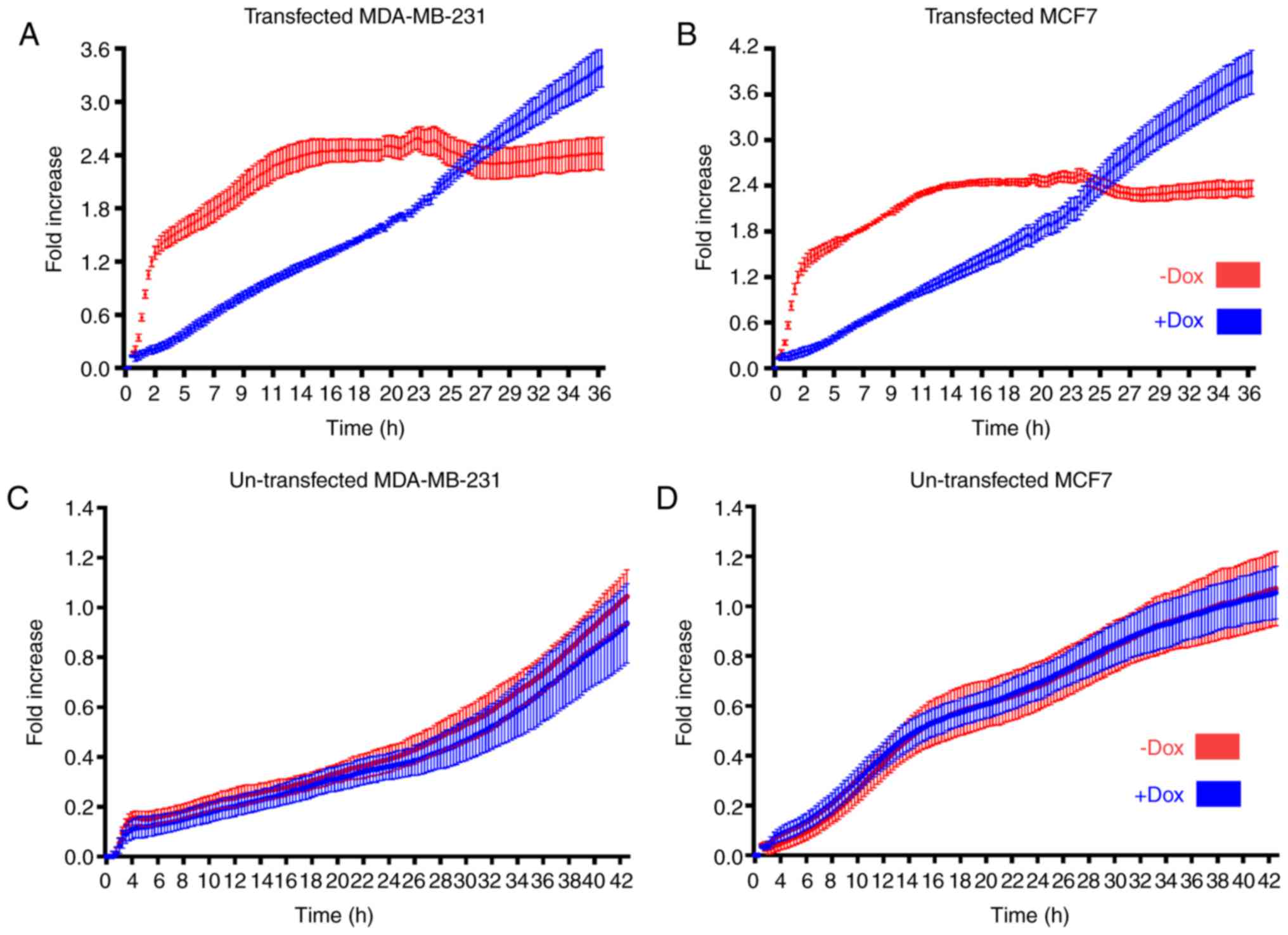|
1
|
Chen Z, Brand NJ, Chen A, Chen SJ, Tong
JH, Wang ZY, Waxman S and Zelent A: Fusion between a novel
Krüppel-like zinc finger gene and the retinoic acid receptor-alpha
locus due to a variant t(11;17) translocation associated with acute
promyelocytic leukaemia. EMBO J. 12:1161–1167. 1993.PubMed/NCBI
|
|
2
|
Li X, Peng H, Schultz DC, Lopez-Guisa JM,
Rauscher FJ III and Marmorstein R: Structure-function studies of
the BTB/POZ transcriptional repression domain from the
promyelocytic leukemia zinc finger oncoprotein. Cancer Res.
59:5275–5282. 1999.PubMed/NCBI
|
|
3
|
Rho SB, Park YG, Park K, Lee SH and Lee
JH: A novel cervical cancer suppressor 3 (CCS-3) interacts with the
BTB domain of PLZF and inhibits the cell growth by inducing
apoptosis. FEBS Lett. 580:4073–4080. 2006. View Article : Google Scholar : PubMed/NCBI
|
|
4
|
Park I, Qian D, Kiel M, Becker MW, Pihalja
M, Weissman IL, Morrison SJ and Clarke MF: Bmi-1 is required for
maintenance of adult self-renewing haematopoietic stem cells.
Nature. 423:302–305. 2003. View Article : Google Scholar : PubMed/NCBI
|
|
5
|
Costoya JA, Hobbs RM, Barna M, Cattoretti
G, Manova K, Sukhwani M, Orwig KE, Wolgemuth DJ and Pandolfi PP:
Essential role of Plzf in maintenance of spermatogonial stem cells.
Nat Genet. 36:653–659. 2004. View
Article : Google Scholar : PubMed/NCBI
|
|
6
|
Yeyati PL, Shaknovich R, Boterashvili S,
Li J, Ball HJ, Waxman S, Nason-Burchenal K, Dmitrovsky E, Zelent A
and Licht JD: Leukemia translocation protein PLZF inhibits cell
growth and expression of cyclin A. Oncogene. 18:925–934. 1999.
View Article : Google Scholar : PubMed/NCBI
|
|
7
|
Felicetti F, Errico MC, Bottero L,
Segnalini P, Stoppacciaro A, Biffoni M, Felli N, Mattia G, Petrini
M, Colombo MP, et al: The promyelocytic leukemia zinc
finger-microRNA-221/-222 pathway controls melanoma progression
through multiple oncogenic mechanisms. Cancer Res. 68:2745–2754.
2008. View Article : Google Scholar : PubMed/NCBI
|
|
8
|
Hurst DR, Edmonds MD, Scott GK, Benz CC,
Vaidya KS and Welch DR: Breast cancer metastasis suppressor 1
up-regulates miR-146, which suppresses breast cancer metastasis.
Cancer Res. 69:1279–1283. 2009. View Article : Google Scholar : PubMed/NCBI
|
|
9
|
Bernardo MV, Yelo E, Gimeno L, Campillo JA
and Parrado A: Identification of apoptosis-related PLZF target
genes. Biochem Biophys Res Commun. 359:317–322. 2007. View Article : Google Scholar : PubMed/NCBI
|
|
10
|
Cheung M, Pei J, Pei Y, Jhanwar SC, Pass
HI and Testa JR: The promyelocytic leukemia zinc-finger gene, PLZF,
is frequently downregulated in malignant mesothelioma cells and
contributes to cell survival. Oncogene. 29:1633–1640. 2010.
View Article : Google Scholar : PubMed/NCBI
|
|
11
|
Suliman BA, Xu D and Williams BR: The
promyelocytic leukemia zinc finger protein: Two decades of
molecular oncology. Front Oncol. 2:742012. View Article : Google Scholar : PubMed/NCBI
|
|
12
|
Savage AK, Constantinides MG, Han J,
Picard D, Martin E, Li B, Lantz O and Bendelac A: The transcription
factor PLZF directs the effector program of the NKT cell lineage.
Immunity. 29:391–403. 2008. View Article : Google Scholar : PubMed/NCBI
|
|
13
|
Weinreich MA, Odumade OA, Jameson SC and
Hogquist KA: PLZF+ T cells regulate memory-like CD8+ T cell
development. Nat Immunol. 11:709–716. 2010. View Article : Google Scholar : PubMed/NCBI
|
|
14
|
Xu D, Holko M, Sadler AJ, Scott B,
Higashiyama S, Berkofsky-Fessler W, McConnell MJ, Pandolfi PP,
Licht JD and Williams BR: Promyelocytic leukemia zinc finger
protein regulates interferon-mediated innate immunity. Immunity.
30:802–816. 2009. View Article : Google Scholar : PubMed/NCBI
|
|
15
|
Sadler AJ, Suliman BA, Yu L, Yuan X, Wang
D, Irving AT, Sarvestani ST, Banerjee A, Mansell AS, Liu JP, et al:
The acetyltransferase HAT1 moderates the NF-κB response by
regulating the transcription factor PLZF. Nat Commun. 6:67952015.
View Article : Google Scholar : PubMed/NCBI
|
|
16
|
Li XL, Blackford JA, Judge CS, Liu M, Xiao
W, Kalvakolanu DV and Hassel BA: RNase-L-dependent Destabilization
of Interferon-induced mRNAs. A role for the 2–5A system in
attenuation of the interferon response. J Biol Chem. 275:8880–8888.
2000. View Article : Google Scholar : PubMed/NCBI
|
|
17
|
Zhou A, Paranjape J, Brown TL, Nie H, Naik
S, Dong B, Chang A, Trapp B, Fairchild R, Colmenares C and
Silverman RH: Interferon action and apoptosis are defective in mice
devoid of 2′,5′-oligoadenylate-dependent RNase L. EMBO J.
16:6355–6363. 1997. View Article : Google Scholar : PubMed/NCBI
|
|
18
|
Fernandes J: Oncogenes: The passport for
viral oncolysis through PKR inhibition. Biomark Cancer. 8:101–110.
2016. View Article : Google Scholar : PubMed/NCBI
|
|
19
|
He Z, Jiang J, Kokkinaki M, Tang L, Zeng
W, Gallicano I, Dobrinski I and Dym M: MiRNA-20 and mirna-106a
regulate spermatogonial stem cell renewal at the
post-transcriptional level via targeting STAT3 and Ccnd1. Stem
cells. 31:2205–2217. 2013. View Article : Google Scholar : PubMed/NCBI
|
|
20
|
Bisbal C, Martinand C, Silhol M, Lebleu B
and Salehzada T: Cloning and characterization of a RNAse L
inhibitor. A new component of the interferon-regulated 2–5A
pathway. J Biol Chem. 270:13308–13317. 1995. View Article : Google Scholar : PubMed/NCBI
|
|
21
|
McConnell MJ, Chevallier N,
Berkofsky-Fessler W, Giltnane JM, Malani RB, Staudt LM and Licht
JD: Growth suppression by acute promyelocytic leukemia-associated
protein PLZF is mediated by repression of c-myc expression. Mol
Cell Biol. 23:9375–9388. 2003. View Article : Google Scholar : PubMed/NCBI
|
|
22
|
Ren Y, Li Y and Tian D: Role of the ABCE1
gene in human lung adenocarcinoma. Oncol Rep. 27:965–970. 2012.
View Article : Google Scholar : PubMed/NCBI
|
|
23
|
Hendig D, Langmann T, Zarbock R, Schmitz
G, Kleesiek K and Götting C: Characterization of the ATP-binding
cassette transporter gene expression profile in Y79: A
retinoblastoma cell line. Mol Cell Biochem. 328:85–92. 2009.
View Article : Google Scholar : PubMed/NCBI
|
|
24
|
Heimerl S, Bosserhoff AK, Langmann T,
Ecker J and Schmitz G: Mapping ATP-binding cassette transporter
gene expression profiles in melanocytes and melanoma cells.
Melanoma Res. 17:265–273. 2007. View Article : Google Scholar : PubMed/NCBI
|
|
25
|
Hlavata I, Mohelnikova-Duchonova B,
Vaclavikova R, Liska V, Pitule P, Novak P, Bruha J, Vycital O,
Holubec L, Treska V, et al: The role of ABC transporters in
progression and clinical outcome of colorectal cancer. Mutagenesis.
27:187–196. 2012. View Article : Google Scholar : PubMed/NCBI
|
|
26
|
Rhodes DR, Yu J, Shanker K, Deshpande N,
Varambally R, Ghosh D, Barrette T, Pandey A and Chinnaiyan AM:
ONCOMINE: A cancer microarray database and integrated data-mining
platform. Neoplasia. 6:1–6. 2004. View Article : Google Scholar : PubMed/NCBI
|
|
27
|
Glass D, Viñuela A, Davies MN, Ramasamy A,
Parts L, Knowles D, Brown AA, Hedman AK, Small KS, Buil A, et al:
Gene expression changes with age in skin, adipose tissue, blood and
brain. Genome Biol. 14:R752013. View Article : Google Scholar : PubMed/NCBI
|
|
28
|
Bewick V, Cheek L and Ball J: Statistics
review 12: Survival analysis. Critical Care. 8:389–394. 2004.
View Article : Google Scholar : PubMed/NCBI
|
|
29
|
Livak KJ and Schmittgen TD: Analysis of
relative gene expression data using real-time quantitative PCR and
the 2(-Delta Delta C(T)) method. Methods. 25:402–408. 2001.
View Article : Google Scholar : PubMed/NCBI
|
|
30
|
Suliman BA: The generation of a
ZBTB16-inducible expression system in the ACHN adenocarcinoma cell
line. J Taibah Univ Medical Sci. 10:359–364. 2015.
|
|
31
|
Kikugawa T, Kinugasa Y, Shiraishi K, Nanba
D, Nakashiro KI, Tanji N, Yokoyama M and Higashiyama S: PLZF
regulates Pbx1 transcription and Pbx1-HoxC8 complex leads to
androgen-independent prostate cancer proliferation. Prostate.
66:1092–1099. 2006. View Article : Google Scholar : PubMed/NCBI
|
|
32
|
Mariani F, Sena P, Magnani G, Mancini S,
Palumbo C, de Leon Ponz M and Roncucci L: PLZF expression during
colorectal cancer development and in normal colorectal mucosa
according to body size, as marker of colorectal cancer risk.
ScientificWorldJournal. 2013:6308692013. View Article : Google Scholar : PubMed/NCBI
|
|
33
|
Ali Bandar S: The role of PLZF in the
TLR-mediated inflammatory response and the oncogenic
characteristics of renal cell carcinoma. 2017.
|
|
34
|
Paine TM, Soule HD, Pauley RJ and Dawson
PJ: Characterization of epithelial phenotypes in mortal and
immortal human breast cells. Int J Cancer. 50:463–473. 1992.
View Article : Google Scholar : PubMed/NCBI
|
|
35
|
Nagaraja G, Othman M, Fox B, Alsaber R,
Pellegrino C, Zeng Y, Khanna R, Tamburini P, Swaroop A and Kandpal
RP: Gene expression signatures and biomarkers of noninvasive and
invasive breast cancer cells: Comprehensive profiles by
representational difference analysis, microarrays and proteomics.
Oncogene. 25:2328–38. 2006. View Article : Google Scholar : PubMed/NCBI
|
|
36
|
Xie J, Nair A and Hermiston TW: A
comparative study examining the cytotoxicity of inducible gene
expression system ligands in different cell types. Toxicology In
Vitro. 22:261–266. 2008. View Article : Google Scholar : PubMed/NCBI
|
|
37
|
Onoda T, Ono T, Dhar DK, Yamanoi A, Fujii
T and Nagasue N: Doxycycline inhibits cell proliferation and
invasive potential: Combination therapy with cyclooxygenase-2
inhibitor in human colorectal cancer cells. J Lab Clin Med.
143:207–216. 2004. View Article : Google Scholar : PubMed/NCBI
|















